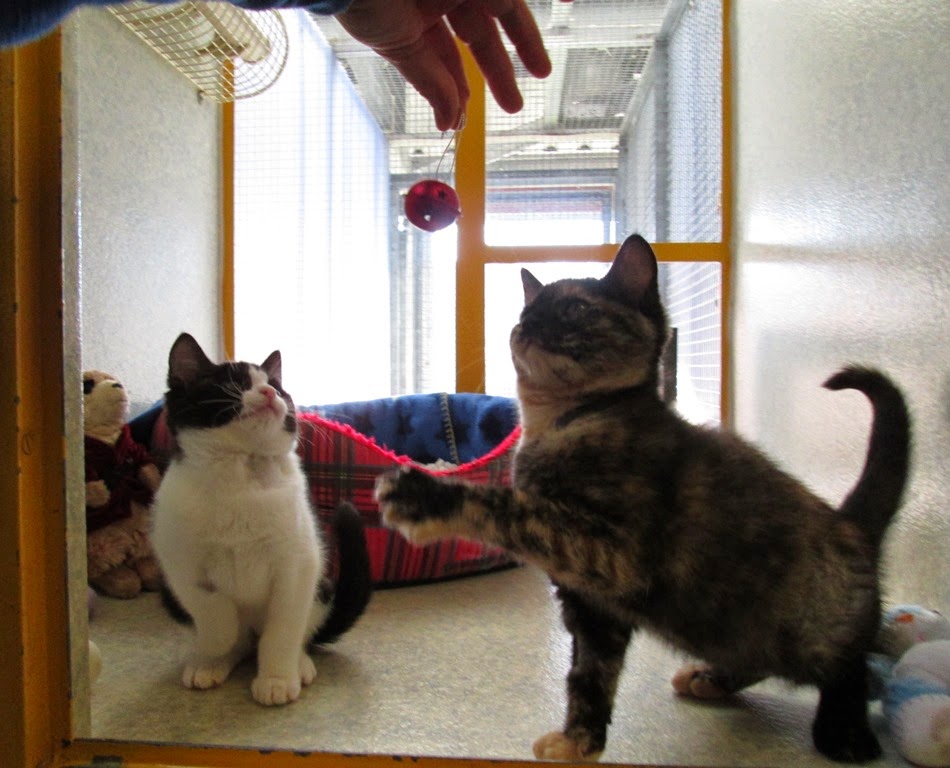Importance of play
Play is important for all
companion cats, young and old. It is a glorious leisure activity and it has a
positive impact on a cat’s emotional state. It aids in the prevention and
treatment of obesity, it provides important stimulation for the bored or
elderly brain and it helps to develop and maintain social bonds.
Development of play
Kittens start to play at two weeks old as they try to bat moving objects, but play behaviour prevalent at four to five weeks old.
-
21-23 days old – “Belly up” and “Stand up” Play
postures
-
32 days old – “Side step” play posture
-
33-35 days old – pouncing, stalking and back
arching
-
38-41 days old – chasing
-
43 days old – wrestling
-
48 days old – “face off” posture
Here at the centre our CCAs provide our kittens a wide variety of toys, which are important for the kittens development and socialistation. As mentioned above helps their physical fitness, hunting skills and mental stimulation.
Play can be broken down into separate categories
which are: -
-
Solitary play
-
Solitary Play (with objects)
-
Interactive play (with cats)
-
Interactive play (with humans)
Solitary play - often occurs during the evening or early hours
of the morning at the time when cats would naturally be most active. Signs of
this type of activity are often referred to as a “mad half hour” which includes
sudden, staccato movements interspersed with frozen postures with crouched legs
and a general look of madness with dilated eyes and flattened ears laterally.
Solitary play with objects – every cat
will have specific favourites when it comes to selecting toys for playing alone.
These are based on the texture, shape, size, smell, how they move and whether
they make a noise while doing so.
Interactive play (with cats) – Cats are
more likely to indulge in social play in the right kind of environment – full
of obstacles and different levels to give camouflage, hidey holes and the
chance to leap to high places for “time out”.
Two cats can differ greatly in their
motivation to play and some sessions can lead to one individual becoming
over-aroused and boisterous, which can change the tone of the game. This can be extremely stressful for the cat that isn’t
quite so excitable. It's important to give both cats the opportunity to break the stare, for
example, in social play fighting can diffuse tension and avoid arousal levels
from escalating. In your home you may need to have a look at areas within your home that might be conducive to play you may want to provide a combination of stacked cardboard boxes – with entry/exit holes – furniture at various heights, tables and cat activity centres to simulate that all important multi-level play station.
Interactive play with humans – Interactive
games with your cat need to be tailored to suit the individual. If your cat is
highly motivated to play you will notice that he or she will do so frequently
and spontaneously at any time of day and night. You will usually be the one who
gets bored first and virtually anything dangled in front of your cat will
elicit a response. If this describes your cat then, congratulations, all you
have to do is develop the staying power to hang on in there with the games and
know that you can have time off by ensuring your cat has plenty of inanimate
objects for self-play when you can take no more or are fast asleep. (Source: Cats Protection)
We are hoping these donated toys will make our cats and kittens stay more enjoyable. With a variety of toys, our cats and kittens can solve food puzzles, brush up on their hunting skills, keep themselves fit and many of our cats will interact with our volunteers or potential adopters with some of these toys. If you would like to donate a gift for our cats and kittens, please visit our Amazon wish list today! http://www.amazon.co.uk/gp/registry/wishlist/2OAP2GCUQHOYK
We would like to thank everyone who has donated gifts for our cats and kittens already, they are making great use of them!
We would like to thank everyone who has donated gifts for our cats and kittens already, they are making great use of them!



.JPG)

No comments:
Post a Comment
Note: only a member of this blog may post a comment.